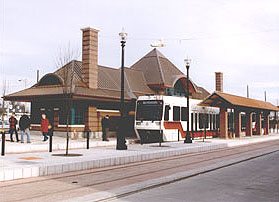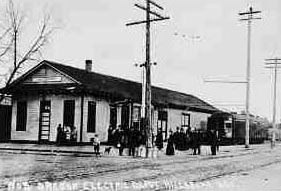Hillsboro Central Area History
 The Hillsboro Central MAX Station pays tribute to the glory days of railroading. The eaves mimic historic railroad stations and also offer shelter to waiting passengers.
The Hillsboro Central MAX Station pays tribute to the glory days of railroading. The eaves mimic historic railroad stations and also offer shelter to waiting passengers.
Hillsboro developed around the land claim of David Hill, a farmer who came to the East Tualatin Plains in the late 1830s. Hill set up the area’s first post office in a corner of his cabin in 1843, naming the post office "Columbus." Oregon’s 1849 territorial government created Washington County and Columbus was named the county seat. Hill died in May 1850 and the new township was renamed Hillsborough in his honor, using the English spelling.
Growth
During the 1850s, a courthouse, jail, log school house and the first hotel were built. The Tualatin River Steam and Navigation Co. began steamboat service to the town in 1865. It provided passenger and mail service as well as a trade of exported agricultural products for imported commercial goods.
Though first refused easements and right-of-way through Hillsborough, the Willamette Valley Railroad opened the county seat to the world in 1872. Sawmills, cereal mills and other food processing businesses were established and newspapers sprang up. Hillsborough was incorporated in 1876, during a decade that brought an opera house, another hotel, two blacksmiths, two general stores, one drug store and four saloons to the growing town.
A modern small town
Changing the spelling of the town’s name to "Hillsboro" was just one sign of the larger changes taking place between 1890 to 1910. In 1890, fire safety brought a requirement that all new commercial buildings be brick or stone; the first such brick building was built on Main St. between 2nd and 3rd.
Railroad
 The Oregon Electric Railway’s station in Hillsboro stood on the same site as TriMet’s Hillsboro
Central MAX Station, but the two stations differed greatly. The OE station functioned
more like a passenger terminal, similar to modern-day Greyhound stations,
while the MAX station is designed for a quicker flow of people.
The Oregon Electric Railway’s station in Hillsboro stood on the same site as TriMet’s Hillsboro
Central MAX Station, but the two stations differed greatly. The OE station functioned
more like a passenger terminal, similar to modern-day Greyhound stations,
while the MAX station is designed for a quicker flow of people.
In 1908, the Oregon Electric Railway brought interurban commuter rail service to Hillsboro. The electric trains changed Hillsboro from a farm-to-market town into a part of the Portland metropolitan area.
Wholesome living
Hillsboro grew steadily, doubling in size between 1900 and 1910 to 2,016 people. During the 1910s, phone service increased, sanitary sewer service was added, a new water supply was located, streets were paved, sidewalks were installed and the first library was built at the NE corner of 2nd and Lincoln. Promotional literature billed Hillsboro as an ideal place to live and raise a family: it had a market center, two newspapers, two hotels, four banks, a wholesome citizenship and no saloons.
World War II brought a massive population increase. Because interurban passenger rail service to Hillsboro stopped in 1932, autos were the mode of transportation. In 1998, rail service returned with the opening of TriMet’s MAX light rail from Gresham to Hillsboro.
